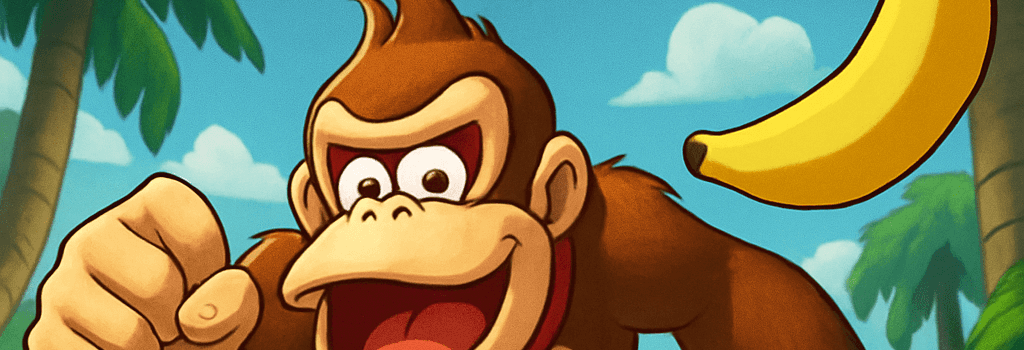Donkey Kong Bananza: Switch 2’s Flagship 3D Platformer

When Nintendo fully unveiled the Switch 2 in April 2025, the industry braced for a big Mario announcement. Instead, Nintendo’s first-party launch title for its next-gen console stars the big ape himself: Donkey Kong Bananza. This marks DK’s first fully 3D adventure since Rare’s Donkey Kong 64 back in 1999. After spending dozens of hours exploring its vibrant worlds and shattering terrain in spectacular fashion, it’s clear that Bananza not only honors Super Mario Odyssey’s legacy but advances the genre with technical polish and inventive design.
Beat up the Earth: Dynamic Terrain Destruction
The headline feature that sets Bananza apart is its groundbreaking terrain destruction system. Three of the Switch 2’s four face buttons map directly to horizontal, upward, and downward punches. Each strike is calculated in real time by Nintendo’s optimized physics engine, which tracks up to 5,000 debris objects per scene without dropping frames.
- Procedural mesh deformation with adaptive tessellation
- GPU‐driven particle effects powered by a custom ray-traced debris shadow pass
- Instant rubble collection via haptic-feedback shoulder buttons
Rendering at a dynamic 1440p docked resolution and a locked 60 fps, the Switch 2’s NVIDIA-Ampere-inspired GPU delivers roughly 4.8 TFLOPS of compute, ensuring even the densest destruction sequences run without stutter. Textures are streamed from the console’s LPDDR5 pool (12 GB unified memory), and advanced occlusion culling ensures debris never overloads the scene.
Getting Around: Enhanced Mobility and Controls
Donkey Kong’s movement toolkit feels as joyful as Mario’s in Odyssey, with new additions:
- Classic Roll returns to extend jumps and alter aerial trajectory.
- Land-Surfing lets DK slide on debris chunks at high speed, utilizing gyroscopic aiming for tight turns.
- Edge Climb expands vertical exploration without pixel-perfect jumps.
Motion-sensing in the Joy-Con enhances terrain-chunk throwing, though aiming can feel slightly loose compared with dedicated shooter titles. Still, these interactions drive many of the world’s situational puzzles, such as hardening lava with ice shards or detonating explosive rocks to clear blocked passages.
Hardware Utilization and Performance
Recent developer interviews reveal Bananza leverages every ounce of Switch 2 hardware:
- Multicore CPU threads handle AI, physics, and animation in parallel.
- Real-time variable rate shading boosts frame rate by reducing detail in off-screen debris.
- An optional high-performance mode (patch 1.1.0) targets 1080p handheld at 60 fps with dynamic resolution scaling.
A hardware-accelerated upscaler—akin to NVIDIA’s DLSS—upsamples lower-res frames to maintain visual fidelity during intense destruction scenes. Early performance logs shared by third-party analysts confirm consistent frame times under 16 ms, even in the most chaotic boss fights.
Technical Design and Engine Insights
Behind the scenes, Bananza runs on Nintendo’s new in-house engine, BTK (Bananza Tech Kernel). Key highlights include:
- Custom physics solver optimized for chunked terrain meshes and dynamic collision.
- Advanced L0/L1/L2 level-of-detail streaming to load cavernous underground zones seamlessly.
- Audio middleware integration for real-time occlusion and reverb in shifting rock tunnels.
“We wanted Bananza to feel as tactile as holding a construction toy in your hands,” says lead engine programmer Yuko Nakamura. “Our physics pipeline processes over 20 million vertex transformations per second.”
Expert Analysis and Future Outlook
Industry experts praise Bananza for balancing technical ambition with accessibility. GamesRadar’s hardware lead notes, “The Switch 2’s enhanced haptics and spatial audio transform every punch into an immersive experience.” Meanwhile, Eurogamer’s performance specialist points out that Bananza’s low-level memory optimizations set a new bar for first-party Nintendo titles.
Looking ahead, Nintendo has hinted at post-launch DLC that will expand Bananza transformations and introduce LAN-play cooperative modes. Prototypes using Labo VR kits are already in testing, suggesting a possible virtual-reality demo by the end of 2025.
Collectibles and Progression
Bananas function analogously to Super Mario Odyssey’s Power Moons but feed into a deeper upgrade system:
- Unlock health tanks and punch upgrades via a multi-branch skill tree
- Acquire longer transformation durations for zebra sprint or ostrich hover
- Purchase protective outfits and endurance buffs with secondary collectibles
Most bananas are optional, encouraging exploration of the game’s sprawling, layered levels. For completionists, hidden challenge rooms test everything from combat finesse to precise terrain destruction.
Plot, Characters, and Worldbuilding
Bananza weaves a delightfully convoluted tale of corporate antagonists mining toward the planet’s core and a cast of talking animals aiding DK’s quest. The standout is a reimagined young Pauline, whose voice-powered melodies serve as a narrative and gameplay catalyst. Her arc—from stage fright to vocal heroism—adds genuine emotional stakes to DK’s smash-and-grab adventure.
Even without Mario himself, Donkey Kong Bananza feels like the defining platformer of this console generation’s launch. It captures the spirit of Odyssey while carving its own technical and creative path.